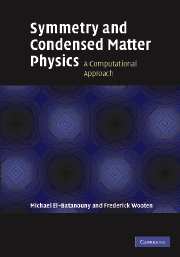Book contents
- Frontmatter
- Contents
- Preface
- 1 Symmetry and physics
- 2 Symmetry and group theory
- 3 Group representations: concepts
- 4 Group representations: formalism and methodology
- 5 Dixon's method for computing group characters
- 6 Group action and symmetry projection operators
- 7 Construction of the irreducible representations
- 8 Product groups and product representations
- 9 Induced representations
- 10 Crystallographic symmetry and space-groups
- 11 Space-groups: Irreps
- 12 Time-reversal symmetry: color groups and the Onsager relations
- 13 Tensors and tensor fields
- 14 Electronic properties of solids
- 15 Dynamical properties of molecules, solids, and surfaces
- 16 Experimental measurements and selection rules
- 17 Landau's theory of phase transitions
- 18 Incommensurate systems and quasi-crystals
- Bibliography
- References
- Index
18 - Incommensurate systems and quasi-crystals
Published online by Cambridge University Press: 06 July 2010
- Frontmatter
- Contents
- Preface
- 1 Symmetry and physics
- 2 Symmetry and group theory
- 3 Group representations: concepts
- 4 Group representations: formalism and methodology
- 5 Dixon's method for computing group characters
- 6 Group action and symmetry projection operators
- 7 Construction of the irreducible representations
- 8 Product groups and product representations
- 9 Induced representations
- 10 Crystallographic symmetry and space-groups
- 11 Space-groups: Irreps
- 12 Time-reversal symmetry: color groups and the Onsager relations
- 13 Tensors and tensor fields
- 14 Electronic properties of solids
- 15 Dynamical properties of molecules, solids, and surfaces
- 16 Experimental measurements and selection rules
- 17 Landau's theory of phase transitions
- 18 Incommensurate systems and quasi-crystals
- Bibliography
- References
- Index
Summary
Introduction
So far we have mainly considered the symmetries of condensed matter systems with regular periodicity in one-, two-, and three-dimensional space (1D, 2D, and 3D). We demonstrated that manifestations of such periodicities are lattice structures in real Euclidean space, and that when a lattice is decorated with an atomic basis we obtain a crystal. Moreover, we showed that there is a finite number of crystal structures, and that each crystal type has a compatible space-group symmetry, comprising point-group and translation operations. In 2D, we classified the lattices into 5 distinct types, with 17 crystallographic space-groups involving 10 point-groups, while in 3D we were able to identify 14 lattices, 230 monochromatic Fedorov space-groups with 32 point-groups, or 1058 Shubnikov dichromatic spacegroups with 58 point-groups. We exhaustively discussed the effect of the lattice structures and their underlying symmetries on the different physical properties of material systems.
However, over the past three decades we have witnessed the emergence of systems that do not exhibit periodic structures, yet display well-defined long-range order, manifest in well-defined diffraction patterns comprising of sharp Bragg peaks. These systems have been named quasi-periodic (QP). The lack of periodicity in QP systems in 2D and 3D leads to the lifting of related constraints imposed on the regular lattices. For example, it was found that certain QP structures admit the packing of two types of cells, pentagonal and icosahedral. This evidence defies previously accepted notions that long-range order was incompatible with both pentagonal and icosahedral packing, let alone that only one type of cell was admissible in crystal packing.
- Type
- Chapter
- Information
- Symmetry and Condensed Matter PhysicsA Computational Approach, pp. 858 - 900Publisher: Cambridge University PressPrint publication year: 2008



